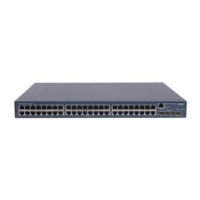1-2
z Current device only supports Layer 2 aggregation group and Layer 2 aggregate interface.
z The rate of an aggregate interface equals the total rate of its member ports in selected state and its
duplex mode is the same as that of the selected member ports. For more information about the
states of member ports in an aggregation group, refer to Aggregation states of member ports in an
aggregation group
.
Aggregation states of member ports in an aggregation group
A member port in an aggregation group is in either of the following two aggregation states:
z Selected: a selected port can forward user traffic.
z Unselected: an unselected port cannot forward user traffic.
Operational key
When aggregating ports, the system automatically assigns each port an operational key based on port
information such as port rate and duplex mode. Any change to this information triggers a recalculation
of this operational key. The operational key of a port indicates the aggregation capability of the port.
In an aggregation group, all selected member ports are assigned the same operational key.
Configuration classes
Every configuration setting on a member port in a link aggregation group may affect the aggregation
state of the port in the group more or less. They are divided into three configuration classes:
z Port attribute configurations, including port rate, duplex mode, and link status (up/down), which are
the most basic port configurations.
z Class-two configurations, as described in Table 1-1. A member port can be placed in selected state
only if it has the same class-two configurations as the aggregate interface.
Table 1-1 Class-two configurations
Item Considerations
Port isolation
Whether the port has joined an isolation group
VLAN
Permitted VLAN IDs, PVID, link type (trunk, hybrid, or access), VLAN
tagging mode
MAC address learning
MAC address learning capability, MAC address learning limit, forwarding
of frames with unknown destination MAC addresses after the MAC
address learning limit is reached

